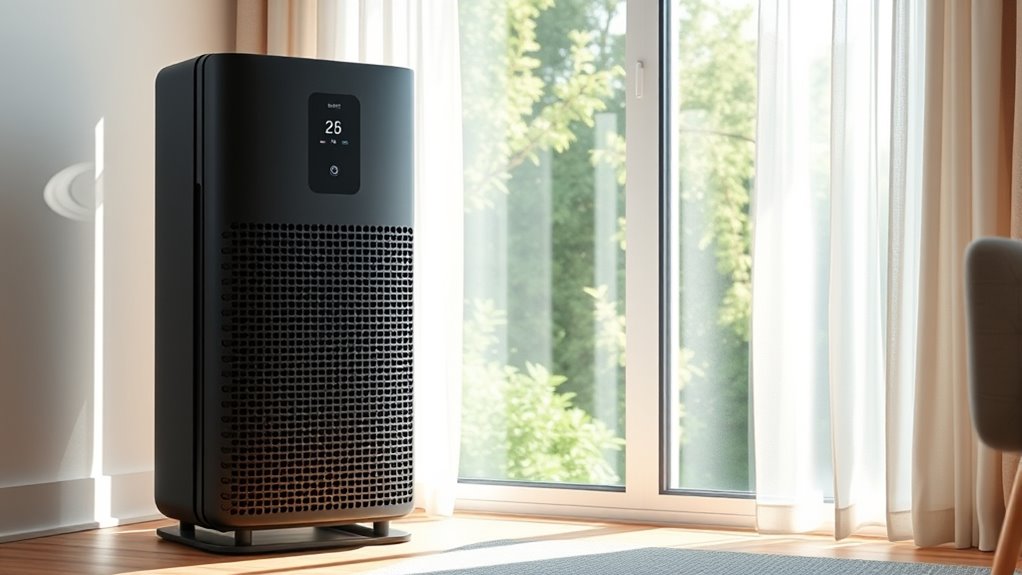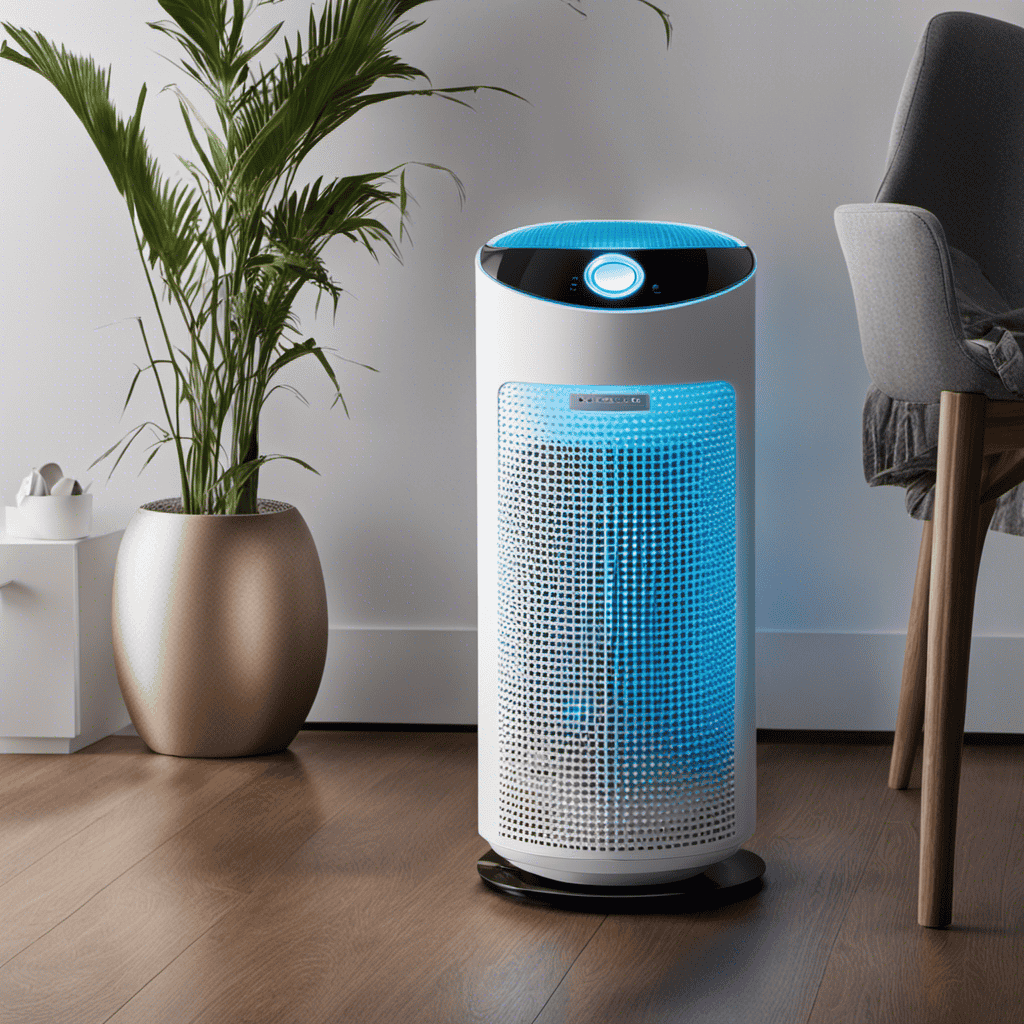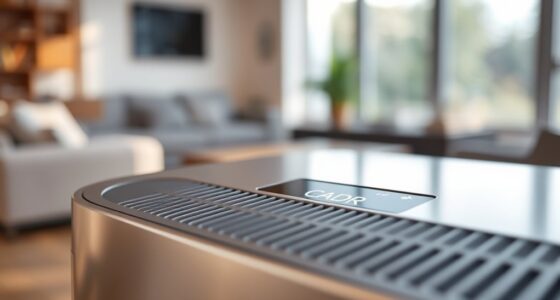Air purifiers mainly filter out airborne particles with HEPA filters and odors or VOCs with activated carbon filters. However, they can’t remove gases like carbon dioxide or radon because these molecules are too small to be captured by traditional filters. To lower CO₂ and radon levels, proper ventilation or specialized mitigation systems are needed. If you want to find out what other options are available for gas removal, there’s more to explore below.
Key Takeaways
- Most air purifiers, especially those with HEPA filters, cannot remove CO₂ or radon gas due to their molecular size.
- Activated carbon filters can absorb some radon but are generally ineffective for significant radon reduction.
- Air purifiers do not effectively lower indoor CO₂ levels; proper ventilation is necessary.
- Radon mitigation requires dedicated systems like soil depressurization, not standard air purifiers.
- To reduce CO₂ and radon, combining ventilation, specialized filtration, and mitigation strategies is essential.
How Do Air Purifiers Work?
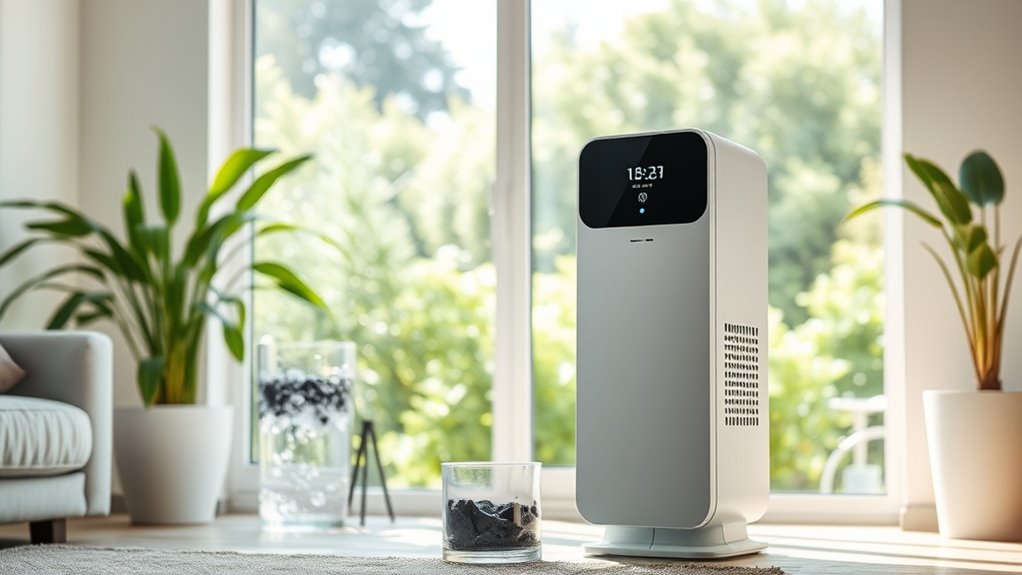
Air purifiers work by drawing in indoor air and passing it through filters that trap pollutants, allergens, and harmful gases. While they mainly target airborne particles, some models also support humidity control, helping you maintain a comfortable environment. Indoor plants can complement air purifier functions by naturally filtering certain toxins and boosting humidity levels. As air passes through the filters, contaminants like dust, pollen, and pet dander get captured, improving air quality. Many purifiers include features to regulate humidity, preventing dry air or excess moisture. This combination creates a healthier, more comfortable space. Additionally, air quality improvement strategies such as integrating automation and monitoring systems can optimize the overall indoor environment. Understanding how air purifiers operate helps you choose the right device for your needs, especially if you want to manage indoor air quality and humidity effectively. It is also important to recognize that ventilation systems play a crucial role in maintaining fresh air circulation alongside air purification. Some advanced models are designed to address specific concerns like removing volatile organic compounds (VOCs) and other gases that traditional filters may not target efficiently. Furthermore, research into AI-driven solutions is expanding the capabilities of air purification technology, enabling smarter and more efficient air management.
Capabilities of HEPA and Activated Carbon Filters
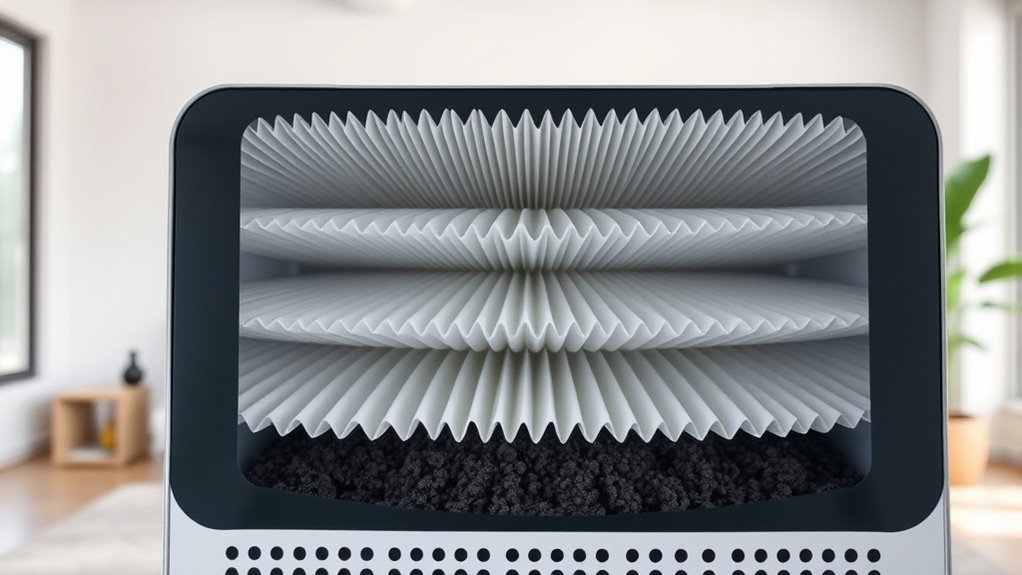
HEPA and activated carbon filters each play an essential role in improving indoor air quality by targeting different types of pollutants. HEPA filters excel at trapping particulate matter like dust, pollen, and pet dander, contributing to cleaner air and better respiratory health. Activated carbon filters, on the other hand, specialize in gas filtration. They absorb odors, volatile organic compounds (VOCs), and other gaseous pollutants, helping reduce indoor odors and harmful emissions. While HEPA filters improve particulate removal, activated carbon enhances overall indoor air quality by addressing gaseous contaminants. Together, these filters create a more exhaustive air purification system. However, it’s important to note that neither is effective at removing gases like carbon dioxide or radon. Their capabilities are limited to specific types of pollutants, primarily particles and certain gases. Additionally, filter technology does not effectively remove gases such as carbon dioxide or radon, which require other specialized solutions. For instance, removing gases like radon often involves specialized ventilation or sealing techniques rather than standard filters. Moreover, understanding the limitations of air purification methods helps in selecting appropriate solutions for comprehensive indoor air quality management. As research progresses, new filter innovations may improve the ability to target a wider range of indoor pollutants.
Why Co₂ and Radon Are Different From Particulate Matter
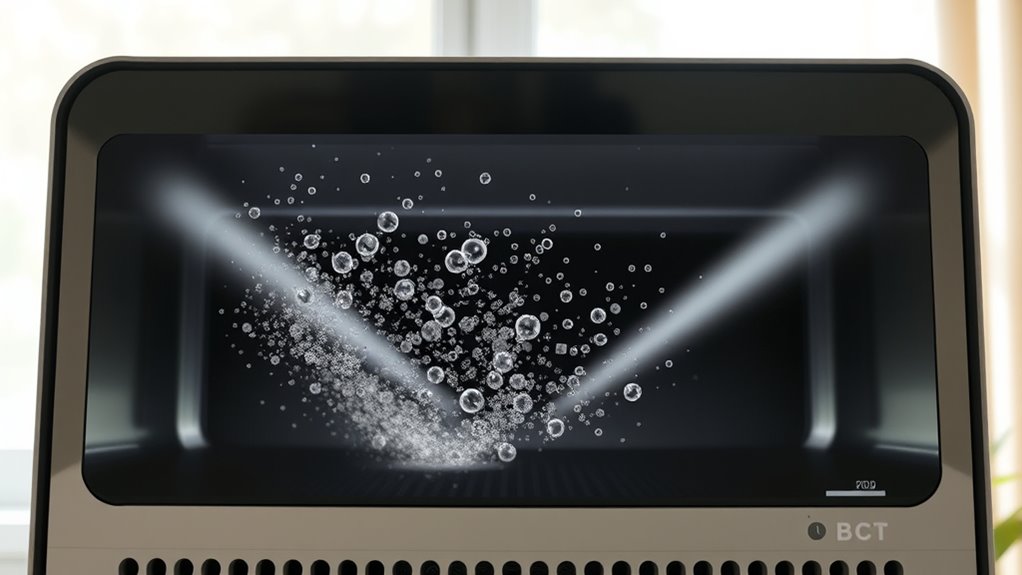
You need to understand that gases like CO₂ and radon behave differently from particulate matter because they are gaseous substances, not solid particles. This means standard filters like HEPA or activated carbon can’t fully remove them from the air. Recognizing these differences helps you choose the right solutions for effective gas removal. Additionally, ongoing AI safety measures are crucial to monitor and mitigate potential vulnerabilities in AI systems that could impact environmental technologies. Since these gases often require specialized detection methods, understanding gas behavior is essential for effective environmental control. Furthermore, knowledge of gas properties can aid in developing more efficient filtration and mitigation strategies, especially considering their diffusion rates in enclosed spaces.
Gaseous vs. Particulate Nature
Gases like carbon dioxide (CO₂) and radon behave differently from particulate matter because they exist as molecules that disperse evenly throughout the air, making them difficult to filter with standard air purifiers. Unlike particles, which can be captured through particulate filtration methods like HEPA filters, gases require gaseous removal techniques, such as activated carbon or specialized filters. Particulate filtration targets solid or liquid particles suspended in the air, but gases slip through these barriers because they are molecular in nature. This fundamental difference means that traditional air purifiers are generally ineffective at removing gases like CO₂ and radon. To address gaseous contaminants, you need devices specifically designed for gaseous removal, not just those relying on particulate filtration.
Filtration Limitations
Because of their molecular nature, gases like carbon dioxide and radon cannot be captured by traditional particulate filters, which are designed to trap solid or liquid particles suspended in the air. These filters rely on physical barriers that block particles too large to pass through. Gases, however, are much smaller and diffuse easily, making filtration ineffective for removal. This limitation means you need different approaches, such as ventilation strategies and specialized gas filtration systems, to reduce these gases. Ventilation helps dilute indoor concentrations by bringing in fresh air, while gas filtration uses activated carbon or other media specifically designed to absorb or adsorb gases. Relying solely on particulate filters won’t improve levels of CO₂ or radon in your space. Additionally, understanding the molecular size of these gases is crucial to developing effective mitigation methods.
Effectiveness of Air Purifiers in Reducing CO₂ Levels
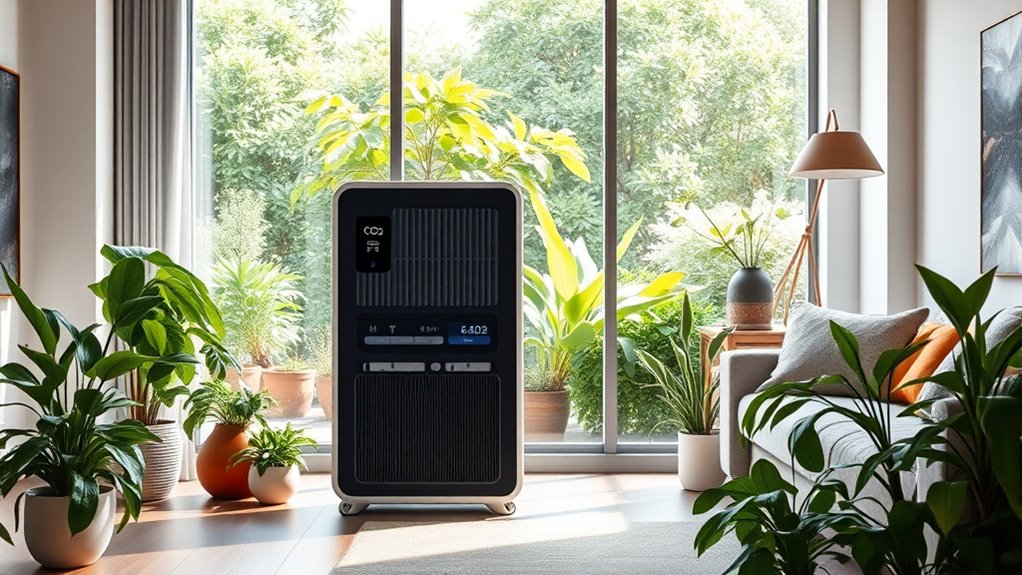
While air purifiers are primarily designed to filter pollutants and improve air quality, their effectiveness in reducing carbon dioxide (CO₂) levels is limited. Air purifier limitations mean they aren’t effective at removing gases like CO₂ because most rely on filters that target particles, not gases. Gas filtration efficiency for CO₂ is generally low in standard air purifiers, as they lack the specialized technologies needed for gas removal. HEPA filters, common in many purifiers, do not absorb CO₂, which is a colorless, odorless gas. If your goal is to lower CO₂ levels, relying solely on an air purifier won’t help. Instead, proper ventilation or dedicated air exchange systems are necessary to effectively reduce CO₂ concentration in indoor spaces. Air purification technologies are primarily focused on removing particulate matter rather than gases like CO₂.
Can Air Purifiers Help Minimize Radon Concentrations?
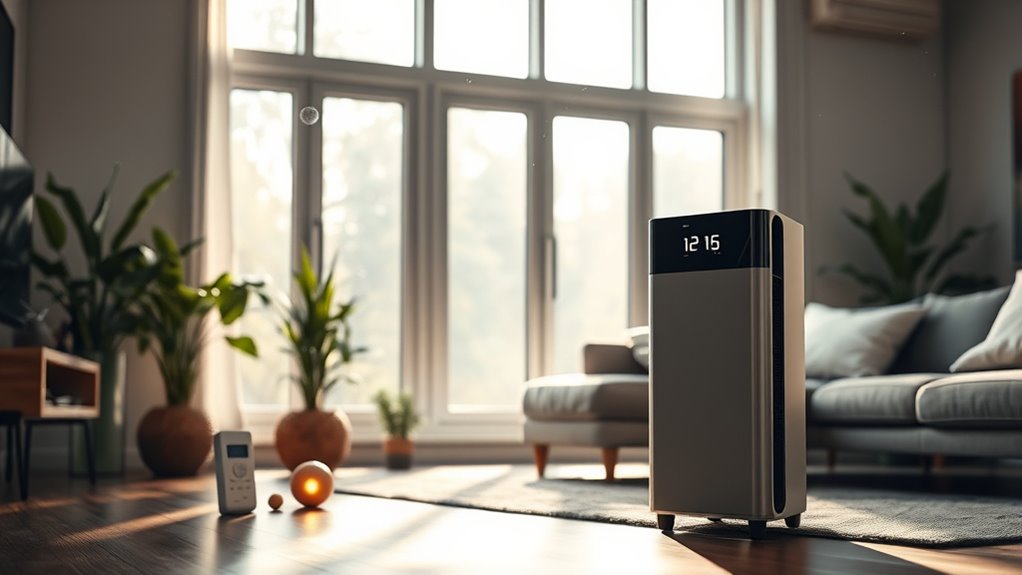
You might wonder if air purifiers can reduce radon levels in your home. While some purifiers claim to filter radon, their effectiveness depends on the type and how you use them. Understanding radon filtration, proper air exchange strategies, and the best purifier types is key to minimizing radon concentrations effectively. Additionally, it’s important to consider air quality management strategies alongside purifiers, as these can significantly impact radon mitigation efforts. Since radon is a radioactive gas that can accumulate in enclosed spaces, employing ventilation techniques can be crucial for reducing indoor radon levels. Incorporating air exchange methods helps to dilute radon concentrations and improve overall indoor air quality. Moreover, understanding the cybersecurity aspects of monitoring systems can help protect your home automation devices from breaches that might interfere with air quality sensors.
Radon Filtration Capabilities
Radon is a radioactive gas that can seep into homes from the ground, posing serious health risks over time. Unfortunately, most air purifiers are not designed for effective radon mitigation because they lack specialized gas filtration capabilities. Radon molecules are heavy and require targeted filtration methods, such as activated charcoal or other radon-specific systems, to reduce concentrations. Standard air purifiers with HEPA filters won’t substantially lower radon levels because they focus on particles, not gases. If you’re concerned about radon, you need a dedicated radon mitigation system that includes proper gas filtration. Air purifiers alone won’t solve the problem; they can help improve overall air quality but aren’t a reliable solution for radon removal. Proper radon mitigation remains the best approach.
Air Exchange Strategies
Air exchange strategies can play a role in reducing radon levels inside your home, but their effectiveness depends on how they are implemented. Increasing air exchange involves introducing fresh air through natural ventilation or mechanical systems. Natural ventilation, such as opening windows and vents, can help dilute radon concentrations, especially if done regularly during times of low radon buildup. Mechanical ventilation systems, like exhaust fans or heat recovery ventilators, can improve air exchange more consistently. However, simply increasing ventilation isn’t always enough if radon entry points remain unchecked. Properly designed air exchange methods work best when combined with radon mitigation measures, such as sealing entry points or installing radon reduction systems. Overall, effective air exchange can contribute to lowering radon levels, but it must be part of a comprehensive approach.
Effective Purifier Types
While air purifiers can improve indoor air quality, not all types effectively reduce radon levels. HEPA filters are great for capturing particles but don’t remove gases like radon. Activated carbon filters can absorb radon, but their effectiveness depends on filter size and airflow. Relying solely on indoor plants isn’t enough, as they don’t substantially lower radon concentrations. To truly assess your radon levels, use air quality sensors designed to detect radon gas. These sensors help you monitor conditions and determine if additional mitigation steps are necessary. For best results, combine radon-specific mitigation methods with air purifiers equipped with activated carbon filters. This approach ensures you’re actively working to minimize radon concentrations and improve overall indoor air safety. Additionally, understanding asset division laws can help inform decisions about property and asset management during home improvements or renovations related to radon mitigation. Considering the performance ratings of air purifiers can also guide you toward more effective products for gas removal. Moreover, selecting air purifier models with proven radon reduction capabilities can significantly enhance indoor safety.
Alternatives for Managing CO₂ and Radon in Indoor Spaces
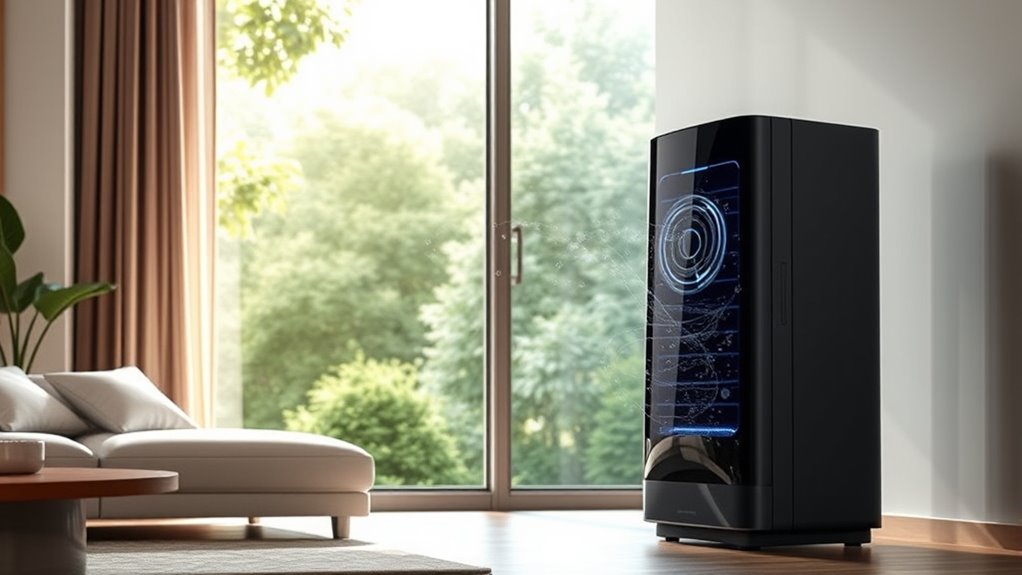
When managing indoor levels of CO₂ and radon, relying solely on traditional ventilation methods might not always be enough. You can explore alternatives like indoor plantings, which naturally absorb CO₂ and improve air quality. Indoor plants can also help by removing other indoor pollutants and creating a healthier environment. Additionally, air humidification systems can also help by balancing humidity levels, reducing the buildup of gases. Properly maintaining these systems is essential for their effectiveness. Using activated carbon filters can also trap radon particles more effectively. To help visualize these options, consider this table:
| Alternative Method | Benefits |
|---|---|
| Indoor plantings | Natural CO₂ absorption, aesthetic boost |
| Air humidification | Maintains humidity, reduces gas buildup |
| Activated carbon filters | Trap radon and other gas particles |
| Mechanical ventilation | Enhances air exchange |
| Sealant applications | Reduce radon entry from foundation |
These strategies, combined with proper maintenance, can markedly improve indoor air quality. Understanding gas infiltration is essential for choosing the most effective mitigation methods. Moreover, integrating advanced filtration technologies can further optimize indoor air safety.
Best Practices for Ensuring Indoor Air Quality
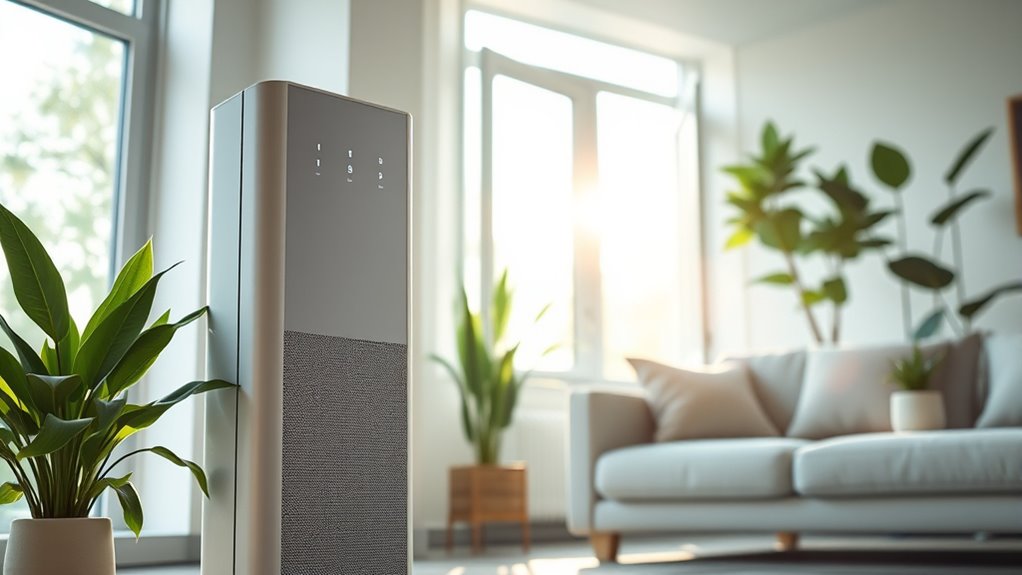
Implementing best practices for ensuring indoor air quality requires a proactive approach that combines proper ventilation, regular maintenance, and careful monitoring. You can improve air quality by incorporating indoor plants, which naturally filter pollutants and increase oxygen levels. Using air ionizers can also help by charging particles so they settle out of the air more quickly. Confirm your HVAC system is cleaned and inspected regularly to prevent dust and mold buildup. Keep humidity levels balanced to discourage mold growth and dust mites. Additionally, monitor indoor air quality with sensors to identify issues early. Consider opening windows daily for fresh air exchange. Understanding air purification technology can further enhance your efforts by selecting devices with features like HEPA filters and UV light. Regularly checking the filter status and replacing filters as recommended ensures ongoing optimal performance. Proper placement of air purifiers is also essential to maximize their effectiveness in reducing pollutants, especially in high-traffic or pollutant-prone areas. These practices create a healthier environment and reduce the need for frequent gas removal interventions.
Technological Solutions for Gas Removal
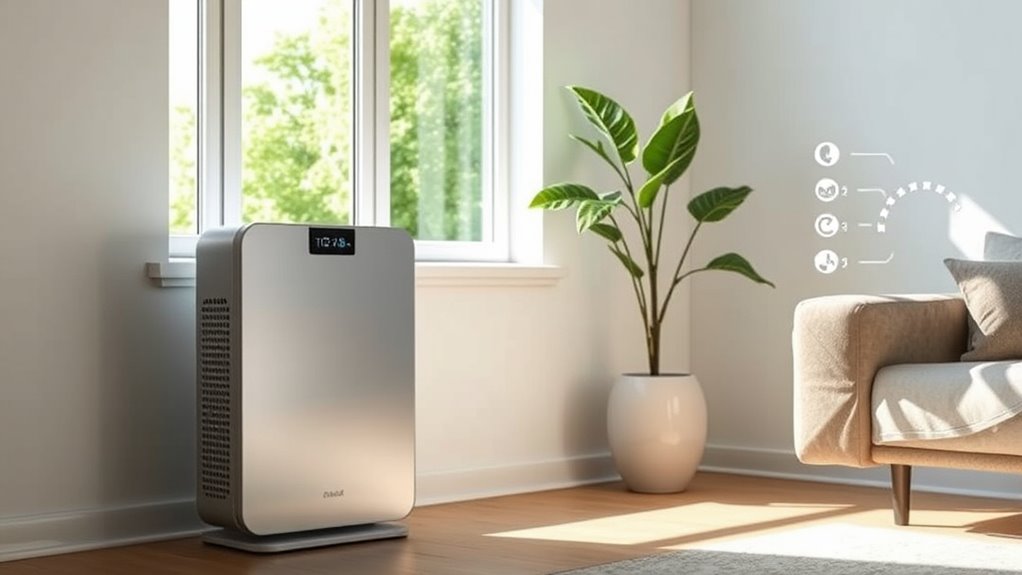
Advancements in technology have introduced highly effective solutions for removing harmful gases from indoor air. Modern air purifiers now incorporate advanced filters and sensors that target specific gases like radon and CO₂, improving indoor air quality. While indoor plant benefits include natural absorption of certain pollutants, they aren’t enough alone to remove high concentrations of gases like radon or CO₂. Proper air purifier maintenance guarantees ideal performance, such as regular filter changes and cleaning. Some models feature activated carbon filters specifically designed for gas adsorption, enhancing their ability to reduce indoor pollutants. These technological solutions provide a proactive approach to gas removal, complementing other strategies and helping you maintain a safer, healthier indoor environment.
Tips for Creating a Safer Indoor Environment
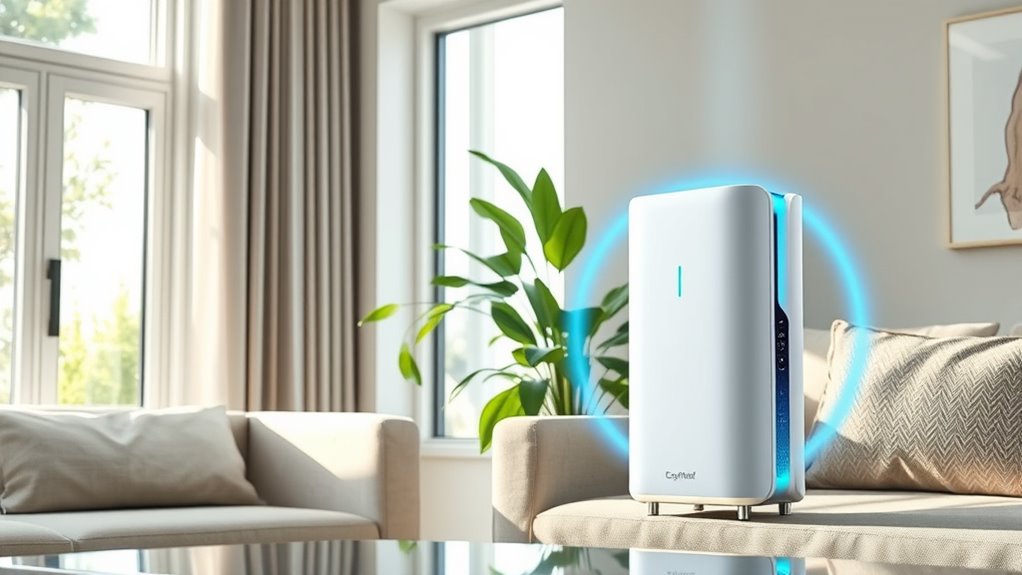
Creating a safer indoor environment starts with understanding the importance of proper ventilation and air quality management. To improve your indoor air, consider regular air purifier maintenance to guarantee it functions efficiently. Additionally, indoor plant benefits go beyond aesthetics; they naturally filter toxins and boost humidity, enhancing air quality. Here are some tips to get started:
- Keep air purifiers clean and replace filters as recommended
- Increase ventilation by opening windows regularly
- Use indoor plants like pothos or snake plants to improve air quality
- Monitor humidity levels to prevent mold growth
Frequently Asked Questions
Can Air Purifiers Detect Elevated Levels of Co₂ or Radon?
You might wonder if air purifiers can detect elevated CO₂ or radon levels. While they don’t perform gas detection, some advanced models include sensors that monitor air quality and alert you to high levels. Keep in mind, filters have a lifespan and need regular replacement to stay effective. For accurate detection of CO₂ or radon, consider specialized detectors instead of relying solely on air purifiers.
Are There Specific Air Purifiers Designed for Gas Removal?
Did you know that only about 1% of air purifiers are designed specifically for gas filtration? While many standard purifiers excel at removing particles, they often can’t handle gases like radon or CO₂. You need specialty purifier types, such as activated carbon filters, to effectively target gas removal. If you’re concerned about radon or CO₂, look for units explicitly labeled for gas filtration to guarantee you get the right protection.
How Often Should Filters Be Replaced to Maintain Effectiveness?
To keep your air purifier working effectively, you need to pay attention to the filter lifespan and replacement frequency. Typically, filters should be replaced every 3 to 6 months, but this varies based on usage and air quality. Regularly check your device’s instructions and indicator lights. Replacing filters on time ensures peak performance, reducing pollutants and maintaining clean air in your space.
Do Air Purifiers Require Maintenance to Handle Gas Filtration?
You might think air purifiers handle everything, but nope—gas filtration isn’t their forte. To keep them effective, you do need to follow maintenance schedules and replace filters regularly. Ignoring filter replacement means reduced performance and no magic fix for gases like CO₂ or radon. So, yes, they require some maintenance, but don’t expect them to be the superhero that cleans every airborne menace effortlessly.
What Are the Safety Standards for Radon and Co₂ Levels Indoors?
You should prioritize indoor air quality by understanding safety standards for radon and CO₂ levels. Radon levels should stay below 4 picocuries per liter, while CO₂ should be under 1000 ppm for healthy air. Gas detection technology helps monitor these gases accurately, ensuring safe indoor environments. Regular testing and ventilation are key to maintaining safe levels, especially in enclosed spaces where gas accumulation can pose health risks.
Conclusion
So, if you’re hoping your air purifier will clear out all that CO₂ and radon, think again. It’s ironic how these devices excel at trapping dust and allergens but fall short on gases. Instead, you’ll need specialized solutions for those pesky gases. So, don’t just rely on your purifier—consider proper ventilation and radon testing. After all, in the quest for clean air, sometimes the simplest fix isn’t enough.
